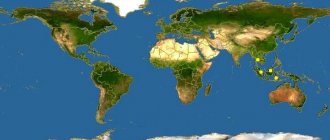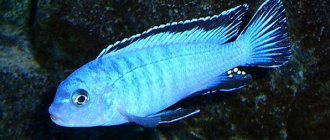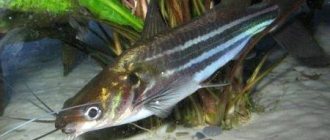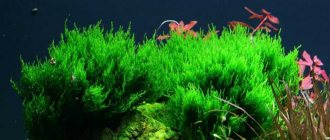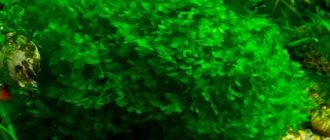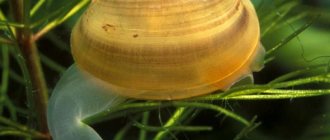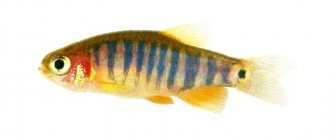In their natural environment, microrasboras live in shallow (up to 1 meter) tropical fresh waters of south-east Asia with abundant vegetation (Philippines, Indonesia, India). These are very bright and unusual fish, often gray-black in color with many light spots, with a yellowish belly. The tail unit consists of two blades. The average lifespan of fish is about two to three years.
Variety of types of microdispersal
The most famous and common types of these wonderful fish will be presented here:
| Microrasbora Galaxy (Danio margaritatus), Stellar | The body is gray with characteristic yellow spots; the fins have a noticeable edging of red and orange. Length 2 cm. |
| Spotted (Boraras makulatus) | It grows up to 2 cm, has an orange or red color, and dark spots are clearly visible on them. |
| Brigitta, the Rasbora mosquito (Boraras brigitta) | It is distinguished by an orange, red color, with a dark blue, shiny stripe running along the body. Grows up to one and a half cm. |
| Ribbon (Mikrorasbora erithromikron) | It is orange in color, with blue and blue vertical stripes running along the entire body. Reaches a length of 2-2.5 cm. |
| Kubotai (Mikrorasbora kubotai) | They are distinguished by a characteristic delicate light green color, the fins are almost colorless, and can grow up to 2.5-3 cm. |
| Measure | They have a light gray (sometimes golden) general background, on which there may be blackish or dark green spots with a red, orange border located on the side from the center of the body to the caudal base. There are up to 2 cm. |
| Maculates | The body is pale red in color and has an orange coating; in the very center on both halves of the body there is a large black spot. There are also 2 pigment spots. Half of the fins are red, the other half is colorless, and the bottom is pale pink. Length 2.5 cm. |
| Green Carplet, Luminous Carplet (Horadandia atukorali) | It is characteristically golden in color and has a green sheen. They grow up to two centimeters. |
| Dracula | There is a golden coating on the head, and the entire body, especially the fins, is almost transparent; all the insides of the fish are clearly visible. In males, teeth-like processes are visible in the mouth; in some, fangs are visible. Size only up to 1 cm. |
| Erythromicron, Emerald Dwarf Rasbora | Along the body, pale blue and pinkish (orange or cream) stripes alternate vertically, the head has a characteristic honey shade. Some of the fins are red, and the ends are completely transparent (or greenish). The tail base has a black spot. Reaches 2.5-2.7 cm in length. |
Whatever type you choose, each of them is beautiful and unique in its own way.
Care and maintenance
Even a beginner can easily handle the maintenance and care of the micro-disassembly. Still, it would be a good idea to familiarize yourself with the basic requirements and rules:
- It is better to select a container based on the size of the flock; it is not advisable to crowd them: count at least a liter of water per individual.
- The jumping ability of the fish requires a top coating.
- A weekly change is required .
- Provide good filtration and aeration , but avoid too much fluidity.
- Periodic high-quality cleaning of the contents of the container.
- Using both floating and fixed plants, creating plenty of hiding places (emptiness makes them shy).
- Creating a substrate of sand at least three centimeters thick.
- Using various driftwood, small stones, caves for decoration.
It is also important to avoid strong lighting.
Basic feeding rules
Almost all varieties of microrasbor are very unpretentious in nutrition, but you still need to balance it by combining and alternating live, frozen and dry food. In addition to the direct health benefits of the fish, you can also achieve an improvement in their color: the pets will have an even better rich color. They can be fed the following live foods:
- bloodworm;
- daphnia;
- tubifex;
- nematodes;
- Artemia;
- cyclops;
- small insects;
- small bloodworms, etc.
Dry food can be given special mixtures designed for carp and small fish species.
It is better to feed newly acquired fish (to avoid stress) with live food, imitating their natural habitat. The introduction of artificial feed into the diet should not be carried out immediately, but after complete adaptation to new living conditions.
When the feed particles are large enough, it is advisable to pre-grind and chop them.
It is also not recommended to feed microrasbor flakes. Since they have a tendency to obesity, it is advisable to feed them no more than 2 times a day. Mobile and small fish will find food for themselves in any case.
Emerald microrasbora (Microrasbora erythromicron)
Emerald microrasbora (Microrasbora erythromicron) ANNANDALE, 1918.
The emerald microrasbora is a shy, but very beautiful fish, which is not very common among aquarists.
Most suitable for keeping in nano-aquariums.
Also called Danio Erythromicron, Microrasbora Tape, Rasbora Erythromicron
.
Habitat:
The emerald microrasbora lives in shallow, densely vegetated lakes in Myanmar.
Description:
The body of the ribbon microrasbora is elongated, dense and colored mainly pinkish-orange, the abdomen is lighter, and the back is brownish. There are vertical stripes of emerald color throughout the body, of which there can be up to 15 pieces. At the base of the caudal fin there is a dark spot with a golden edge. The gill covers are reddish in color.
Female Erythromicron zebrafish are plumper and larger than males, their fins are transparent, and the males are red-orange, like the throat.
The miniature fish grows no more than 3 cm.
Arrangement and parameters of the aquarium:
The dwarf rasbora is a schooling fish, so it is advisable to keep it in numbers of at least 10 individuals, for which a container of 20-30 liters will be sufficient.
The presence of densely planted plants is mandatory, since the emerald microrasbora is a very shy fish. In this case, there should be free areas for swimming, which will also allow the zebrafish to be observed. Driftwood would also be appropriate.
Against the background of a dark background and soil (necessarily fine), erythromicrons look much brighter.
Too bright light scares the fish, so to dim it, you need to place floating plants in the aquarium.
Filtration should be smooth, simulating the natural environment for micro-assortion. Aeration and 30 percent weekly water changes are also necessary.
Water parameters:
22-28°C, optimal 23-26°C, pH 6.5-7.7, dGH 5-18°.
As neighbors for dwarf rasbora (Microrasbora erythromicron)
Only the same tiny and peaceful species will do. In addition, zebrafish become more confident in the presence of fish of similar size and living in the middle water layers and near the surface. The best neighbors would be Espei's rasbora (Trigonostigma espei), Amanda's tetra (Hyphessobrycon amandae), miniature characins and rainbow fish.
When kept with large and aggressive species, the emerald microrasbora will constantly hide.
It is possible to keep them with shrimp, but only with adults, since zebrafish can eat babies.
Nutrition:
The ribbon rasbora has a very small mouth, so the food should be small: cyclops, brine shrimp, daphnia, tubifex, karetra. Dry and frozen foods can also be used if they are ground beforehand. The presence of Artemia and Cyclops in the diet enhances the coloration of zebrafish and prepares them for spawning.
Reproduction:
under comfortable conditions, emerald microrasbora can spawn in a general aquarium. Eryromikrons spawn continuously, but, given that the parents do not mind eating their eggs, as a rule, a very small number of fry survive.
To obtain fry in sufficient quantities, you will need a spawning tank of 10-20 liters, which can accommodate several pairs ( Microrasbora erythromicron
). For successful spawning, males and females are kept separately for several weeks, and the basis of nutrition during this period is live food.
The fish should be released into the spawning tank in the evening, first the females, then the males. The darkness helps them get comfortable, and in the morning, as a rule, spawning begins.
The female lays tiny amber eggs, no more than 1 mm in diameter, on moss, which must be immediately removed so that the producers do not eat the eggs, and a new one placed in its place.
After a week, the adults are placed in a common aquarium.
At a stable temperature of 25° C, the development of larvae lasts 3 days. You can start feeding the fry when they learn to swim horizontally without falling to the bottom.
Starter feeds are “live dust”, ciliates, as well as specialized live and dry foods intended for fry, then cyclops and artemia nauplii.
Fry that have reached 1 cm in length can be transplanted into a community aquarium.
If the necessary conditions are provided, Microrasbora emerald (Microrasbora erythromicron)
lives up to 3 years.
Reproduction and spawning of microrasbora
The fish reach sexual maturity by the age of three months. They breed in the aquarium at any time of the year and do not spawn without any stimulation. This species is egg-laying and does not subsequently care for its offspring.
Microrasboras can also reproduce in their tank, provided there is enough green algae there. But still, getting good offspring requires setting up a separate spawning tank with a volume of 10-15 liters, which is filled with water from your own aquarium. A moss bed or a protective mesh of nylon threads is placed on the bottom to prevent eating your eggs, a little greenery is placed, and the lid is closed to allow air access. There is no need to additionally illuminate or filter the spawning ground; only minimal aeration is used. Further scheme of action:
- One pair or group of two males and several females is selected and carefully moved into the prepared spawning area using a disinfected cup.
- First, the females are released, then the males (after 3 hours).
- Mating games last for several days; one female can lay up to 30 eggs.
- Then the fish need to be transplanted back into the common tank before they have time to eat their eggs.
- The eggs have an incubation period of three days, then they are attached to the walls of the container and will remain motionless for up to four days.
- After they begin to move independently, you need to start feeding them with ciliates, green water, and microworms.
It is not recommended to use dry mixtures to feed fry.
Microrasbor fry grow and develop slowly over three months. The characteristic color appears only around the 12th week.
Breeding
Microrasboras become sexually mature at the age of 3 months.
Breeding Boraras is best done in a separate aquarium with a volume of 30-40 liters per 10 individuals. For landscaping, densely planted algae are used, and moss is used as a substrate. Environmental parameters: temperature about +25 °C; hardness – 7 dH; acidity – 6.5-7.5 pH.
A week before breeding, male and female individuals are separated from each other, being fed abundantly with food with a high protein content. Then they form either pairs or a flock consisting of one male and several females.
Mikrorasbora lays eggs in portions, 2-3 times weekly, forming a clutch of 20-50 granules, after which the breeders are separated from the offspring. The ripening time for caviar is about 3 days. After another 2 days, the larvae become fry and begin to move freely around the aquarium.
Suitable starter feeds include:
- cyclops;
- nematodes;
- Daphnia;
- ciliates;
- rotifers;
- Artemia, etc.
The use of dry mixtures for fry is not recommended.
They acquire full, bright color by six months of age.
How to distinguish a female from a male?
Although sexual dimorphism in individuals of this species is very weakly expressed, it is still quite possible to distinguish a male from a female, especially during the mating season: in males the color becomes even more intense, and in females the body outlines are rounded and become larger.
In general, females are paler, smaller than males, and the pelvic fins of females are less colored. Males often swim around females, trying to court them and gain favor. They can even start “fights” among themselves.
Description and natural habitat
The natural habitat of Microrasbor is shallow, up to 1 m, tropical fresh (and for some varieties, brackish) reservoirs with dense vegetation in the south-eastern part of Asia.
The body of Boraras fish is elongated, the head is flattened. There are small whiskers at the base of the mouth. Sexual dimorphism is weakly expressed - it is quite difficult to distinguish a female from a male, however, females are characterized by a rounded shape, as well as a larger size.
The color and length of the body depend on which species they are from.
Microrasboras are peace-loving fish. Packy. Hyperactive: spend a considerable part of their life cycle in motion. They are distinguished by their jumping ability.
Life expectancy is on average about 2 years.
What do you need to know about microassembly compatibility?
Although this species is a peace-loving fish, during the mating season males can be aggressive towards other males. In general, they get along well with other species of approximately the same size and behavior, but predators and larger individuals will be undesirable neighbors.
| Compatible: | Incompatible: |
|
|
|
|
|
|
| |
|
|
| |
| |
| |
| |
|
Behavior and Compatibility
Peaceful, active fish, they prefer to be in a school of 20 or more individuals. Intraspecific relationships are built on competition between males, sometimes quite fierce, which cannot be said when looking at these miniature fish. When in a large group, weaker individuals will be relatively safe, since the attention of alpha males will be distracted by other relatives. Due to its size, the choice of aquarium neighbors must be treated with great attention. Zebrafish are only compatible with species of comparable size. Any large fish, even if it is a peaceful vegetarian, can accidentally eat them.
What diseases can develop?
The causes of diseases can be non-compliance with maintenance rules or infection with various infections and fungi. Let's briefly look at the main diseases:
- Oodinosis (velveteen disease) is transmitted by single-celled aquarium parasites. Scales peel off, tubercles may appear, fins may be injured, and breathing may be difficult (treatment with Bicillin-5). For the purpose of prevention, you need to add table salt to the tank.
- Lepidorthosis (ruffled scales) refers to one of the types of bacterial infections in which the scales detach and pustules form on the body. In the early stages, antibiotics are used for treatment, and in the later stages, the fish are disposed of. The aquarium is disinfected (with hydrochloric acid), the soil is changed, and the algae are also treated with an antibiotic.
- Trichodinosis. The causative agents are ciliates. The fish experience damage to their gills and scales, mucus appears, they refuse food, and rub against the surface of the substrate and plants. Treatment consists of increasing aeration and water temperature. Infected fish are treated in a saline solution. Preventive measures include maintaining hygienic conditions and mandatory quarantine.
- Bug-eyed. The causative agents can be bacteria, viruses, and fungi. The reason may be poor water composition, violation of filtration requirements, soil purification, or lack of vitamins. The fish's eyes protrude and the cornea becomes cloudy, leading to blindness. Treatment consists of eliminating the causes and increasing immunity.
- Exhaustion. The main reason may be poor-quality food or a lack of food due to it being eaten by “predators”, stronger individuals. Malnourished fish develop lethargy, weakness, and apathy. In this case, you urgently need to change the food, separate the starving fish and supplement them with food.
- Obesity. It is observed when the diet is unbalanced and the portions for feeding are exceeded. The fish become overweight, lethargic, and refuse to eat. It is advisable to organize “fasting” days.
Thus, microrasbors are ideal for lovers of small aquarium species: they look very beautiful, are unpretentious, and if you understand the basics of their maintenance, they will delight their owners with a fun game for several years. These bright fish are a decoration for any aquarium and will not leave anyone indifferent.
Habitat
Originates from Southeast Asia from the territory of central Myanmar.
It lives in Inle Lake, located in a mountainous area at an altitude of 900 m above sea level in the Shan Plateau region. The lake has a shallow depth, only 2–3 meters, a loamy substrate, the water is clear, but along the banks it can be cloudy due to suspended silt. “Vegetation islands” of clusters of aquatic plants float on the surface of the water, serving as a home for many species of fish, including the Emerald Danio. Brief information:
- Aquarium volume - from 50 liters.
- Temperature - 20–24°C
- pH value – 7.0–8.0
- Water hardness - 12–21 dGH
- Substrate type - soft dark
- Lighting - dim
- Brackish water - no
- Water movement – little or no movement
- The size of the fish is about 2 cm.
- Food - any food of suitable size
- Temperament - peaceful
- Keeping in a group of 20 individuals

